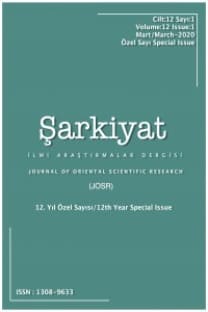CEMALEDDIN AFGANİ'NİN EDEBİ KİŞİLİĞI VE ŞİİRLERİ
XIX. yüzyıl İslam dünyasının önemli fikir ve siyaset adamlarından Afgani’nin edebi ve sanatsal yönünü yansıtan, duygu ve düşüncelerinin anlaşılmasında önemli yer tutan bazı şiirleri mevcuttur. Arap ve Fars edebiyatının yanı sıra farklı dillerin edebiyatlarına da aşina olan Afgani, çeşitli münasebetlerle yazmış-dillendirmiş veya not almış olduğu şiirler vasıtasıyla mesajlar vermiş veya kendisi ile halvet etmiştir. Onun şiirleri arasında en uzun ve en hacimli olanı toplam doksan beyitlik Sakinâme’dir. Bunun dışında rubai, gazel, mesnevi ve kaside kalıplarında yazmış olduğu Arapça ve Farsça şiir ve tek beyitleri de mevcuttur. Afgani söz konusu bu manzumelerle şiir, edebiyat ve estetik zevkini yansıttığı gibi; çalkantılı hayat(ın)a bakışını, yaşadığı siyasi zorluk ve mihnetleri de bir tür rumuz diliyle aksetmiştir. Osmanlı devlet adamlarına göndermelerin de yer aldığı söz konusu şiirlerin çevirisini sunup; ülkemizde edebi yönüyle pek tanınmayan Afgani’nin şiir, sanat ve edebiyat anlayışına ışık tutmaya çalışacağız. Abstract There are some poems that have an important place in understanding of his emotions and thoughts, reflecting the literary and artistic aspect of the Afghani, one of the important ideas and politicians of the 20th century Islamic world. Being familiar with Arabic and Persian literature, as well as literatures of different languages, the Afghani has despacthed messages or has been alone with his own inner world through the poems he had written or noted in a variety of ways. The longest and most voluminous of her poems is Sakinâme with a total of ninety couplets. In addition to this, there are also poetry and single poems written in Arabic, Persian and Persian in the form of rubai, gazel, mesnevi and kaside. As these poems reflect the poetic, literary and aesthetic taste of Afghan; the political difficulties in his view of the turbulent (his) life and his political difficulties are reflected in his pseudonym language. Based on these poems, which include references to Ottoman statesmen, he presented the translation of poems; we will try to shed light on the poetry, art and literature understanding of Afghani, who is not recognized in our country with his literary aspects.
Anahtar Kelimeler:
Seyid Cemaleddin, Şiir, Edebiyat, Sakiname, Afgani
CEMALEDDIN AFGHANI'S LITERARY PERSONALITY AND HIS POEMS
Abstract There are some poems that have an important place in understanding of his emotions and thoughts, reflecting the literary and artistic aspect of the Afghani, one of the important ideas and politicians of the 20th century Islamic world. Being familiar with Arabic and Persian literature, as well as literatures of different languages, the Afghani has despacthed messages or has been alone with his own inner world through the poems he had written or noted in a variety of ways. The longest and most voluminous of her poems is Sakinâme with a total of ninety couplets. In addition to this, there are also poetry and single poems written in Arabic, Persian and Persian in the form of rubai, gazel, mesnevi and kaside. As these poems reflect the poetic, literary and aesthetic taste of Afghan; the political difficulties in his view of the turbulent (his) life and his political difficulties are reflected in his pseudonym language. Based on these poems, which include references to Ottoman statesmen, he presented the translation of poems; we will try to shed light on the poetry, art and literature understanding of Afghani, who is not recognized in our country with his literary aspects.
Keywords:
Afgani, Sayyed Cemaleddin, Literature, Sâkî-nâme,
___
- AFGANİ, Cemaledin, Abduh, Muhammed, [1987] El-Urvetu’l-Vuska (1884), Türkçesi: İbrahim Aydın, Bir Yayıncılık, İstanbulÂSIM EFENDİ, Mütercim, [2009], Burhân-ı Katı, Haz: Derya Örs, Mürsel Öztürk, TDKY, İstanbulBEYHAN, Mehmet Ali [2010] Şirvânîzâde Mehmed Rüşdü Paşa, TDV İslam Ansiklopedisi, c. 39, s.209-210CEVAD SAHİBÎ, Muhammed, [2010] İttihat Bayraktarı Seyyid Cemaleddin Hüseynî, Ter: Sedat Baran, The World Forum for Proximity of İslamic Schools of Thought, TahranÇAĞIN, Şerife, HUYUGÜZEL, Ömer Faruk [2006] Eşref, Bütün Eserleri, Dergâh Yayınları, İstanbulDEHHUDA, Ali Ekber, [1391/2012] Lugatname-yi Dehhuda, İntişarat-e Danişgah-e Tehran, cd-1-2,TahranEL-HÛLU, Müştak, [1380/2001] Nakş-i Seyid Cemaleddin Esedabâdi der Tehavvülat-i Siyasi ve İctimai-ye İran, İntişarat-ı Abid, TahranEMİR ERDUŞ, Muhammed Hüseyin [1384/2006], Teâmuli ber Meseley-i Vahdet-i İslami ez Dirbâz ta Dirûz ba Tekiyeh ber Conbeş-i İttihad-i İslam, Mecme-i Cihanî Tekarib-i Mezahib-i İslami, TahranHAN MELİK-İ SASANİ, Ahmed, [Bi-tarih] Siyasetgeran-ı Dovre-ye Kacar, Babek, TahranHOSRO ŞAHÎ, Seyid Hadi, [1395/20116] Esnad-ı Vezaret-e Harice-yi İran Derbareye Seyid Cemaleddin Hüseyni (Esedabadi), İntişarat-e İttilaat, TahranHOSRO ŞAHÎ, Seyid Hadi, [1395/20116] Esnad-ı Vezaret-e Umur-e Harice-ye İngiliz Derbareye Seyid Cemaleddi Esedabadi, İntişarat-e İttilaat, TahranKAHRAMAN, Hayrettin, [1994] Efgânî, Celâleddin, DİA, c. 10, s.456-466, Türkiye Diyanet Vakfı Yayınları, İstanbulKARAİSMAİLOĞLU, Adnan [2009] Fars Edebiyatında Sâkînâmeler, DİA c. 36, s.14-15 Türkiye Diyanet Vakfı Yayınları, İstanbulKARADENİZ, Yılmaz, [2017] Osmanlı ve İran’ın İngiliz Paraleli Cemaleddin Esedâbadi (Afgani), Gece Kitaplığı, AnkaraKORTANTAMER, Tunca, [1983] Sâkînâmelerin Ortaya Çıkışı ve Gelişimine Genel Bir Bakış, Türk Dili ve Edebiyatı Araştırmaları Dergisi II (Prof.Dr. Harun Tolasa Özel Sayısı), s.117-123, Ege Üniversitesi Yayınları, İzmirKURBANOV, Şamil, [2010] Cemaleddin Afgani ve Türk Dünyası, Doğu Kitabevi, İstanbulMAHZUMÎ PAŞA, Muhammed, [2010] Cemaleddin Afganî’nin Hatıraları, Ter: Adem Yerinde, Klasik, İstanbulMEHDEVİ, Asgar, EFŞAR, İreç, [1342/1963] Mecmua-i Esnad ve Medarık-e Çap Neşode Derbareyi Seyid Cemaleddin, Meşhur be Afgani, Çaphaneyi Danişgah-ı Tehran, TahranMUSTEFEVİ, Ali, [Bi-tarih] Risaleyi Manzum-e Nan û Helva-ye Şeyh Bahaî, Nushay-e Elektroniki, Tahran ŞİRAZİ, Hafız [2017] Hafız Dîvânı, Çev: Abdülbâki Gölpınarlı, T.İ.B. Yayınları. İstanbulTABATABAÎ, M.Muhit, [1380/2001] Seyid Cemalleddin Esedabadi ve Bidari-ye Meşrik Zemin, Haz: Seyid Hadi Hosro Şahî, Şuruk, 1380, Tahran
- Başlangıç: 2009
- Yayıncı: Şarkiyat Araştırmaları Derneği
Sayıdaki Diğer Makaleler
SÜHREVERDÎ, İBNÜ’L-ARABÎ VE MOLLA SADRÂ’DA VARLIK DÜŞÜNCESİ
YAYGIN DİN EĞİTİM KURUMLARINDA TEKNOLOJİNİN ÖNEMİ VE KULLANIMI
USLÛBA PESNÊ PÊXEMBER DI MEWLÛDA YEKEM A KURDÎ DE
CEMALEDDIN AFGANİ'NİN EDEBİ KİŞİLİĞI VE ŞİİRLERİ
TARİHİ SÜREÇTE HAKKÂRİ’DE FAALİYET GÖSTERMİŞ OLAN BAŞLICA TARÎKATLAR VE TEMSİLCİLERİ
BİR HÂFIZ DÎVÂNI ŞERHLERİ DERLEMESİ: ZÂHİD BİN MUHAMMED VE ESERİ
BERAWIRDKIRINA TAYBETIYÊN DAÇEKÊN KURDÎ BI DAÇEKÊN INGILIZÎ RE (“BI”YA KURDÎ DIGEL “BY”A ÎNGILIZÎ)
TARİHİ SÜREÇTE AKLIN ERİLLİĞİ SORUNU VE MÜSLÜMAN DÜŞÜNCESİNDEKİ YANSIMALARI
